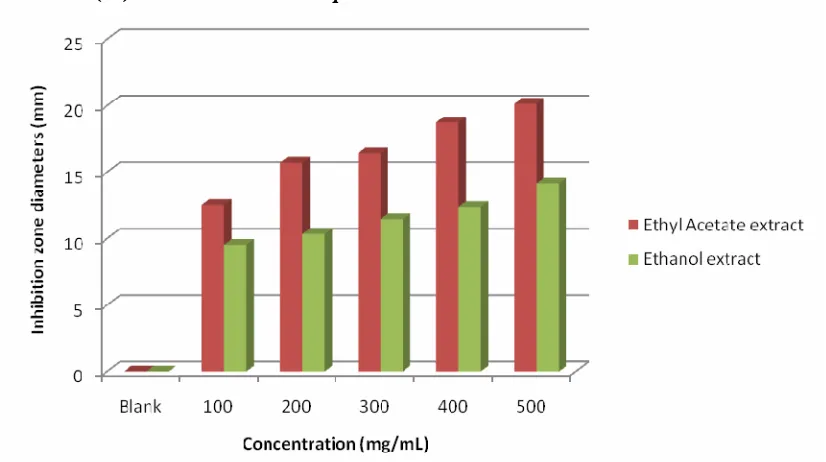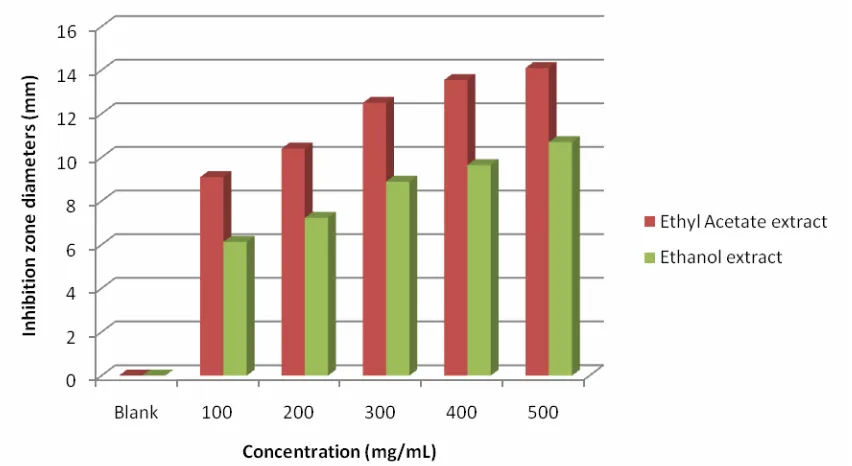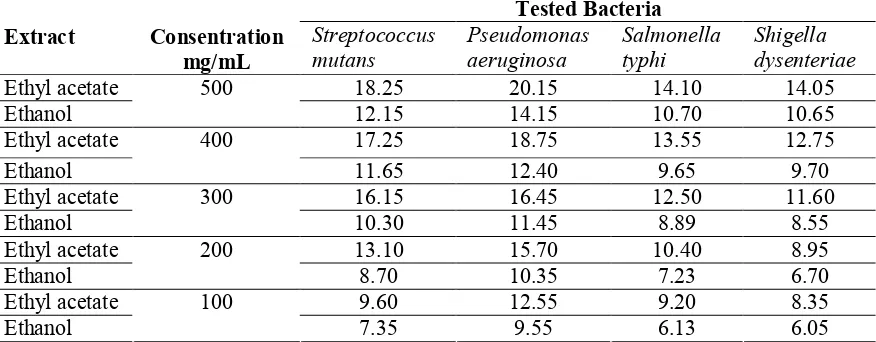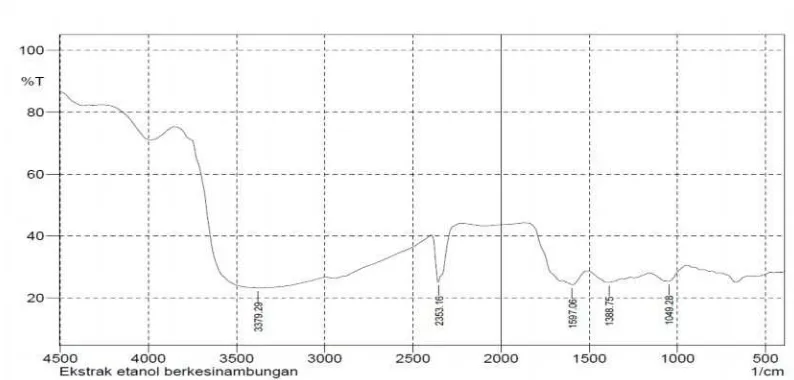2015
Antibacterial activity of Ethyl Acetate and
Ethanol extract of
Rhaphidophora pinnata (L.f) Schott leaf
against four types of Bacteria
Masfria
Faculty of Pharmacy
,
University of Sumatera Utara
,
Medan
,
North Sumatera,
20155,
Indonesia
Abstract: The people of Indonesia have used traditional medicine including parts of plants to treat various infections caused by bacteria. One of the plants used by the community as anticancer and antibacterial drug is
Rhaphidophora pinnata (Lf) Schott leaves. To determine the antibacterial activity of ethyl acetate and ethanol extracts of Rhaphidophora pinnata (Lf) Schott leaves againstStreptococcus mutans,Pseudomonas aeruginosa,
Salmonella typhi andShigella dysenteriaebacteria, and the functional groups of each extract.
Antibacterial activity of was tested using the agar diffusion method and their functional groups were determined using Infrared spectrophotometer.
Phytochemical screening showed that extracts contained the alkaloids, glycosides, saponins, flavonoids, tannins, and triterpenoida/steroid compound. Antibacterial activity of ethyl acetate extract (EARP) gave satisfactory results to the four bacteria with different concentrations.
The ethanol extract (ERP) at a concentration of 500 mg/mL provided a satisfactory activity against
Pseudomonas aeroginosa. Both extracts contained the OH group, C=O, CO, and C=C aromatic which may have antibacterial activity.
Ethyl acetate extract gave a satisfactory antibacterial activity against four types of bacteria. The characteristic result obtaineded Infrared Spectrophotometer showed functional groups of OH, C=O, CO, aliphatic chain and aromatic C=C which have antibacterial property.
Keywords: Rhaphidophora pinnata, Streptococcus mutans, Pseudomonas aeruginosa, Salmonella typhi, Shigella dysenteriae, antibacterial, activity.
Introduction
Infection is the entry of microorganisms into the body, then multiply and cause disease [1]. The development of infection in tropical Indonesia is caused by humid air, poor sanitation, environment densely populated and low socioeconomic level. The treatment of infection is done commonly with antibiotic therapy. The use of antibiotics for local infections such as wounds have been reduced due to the tendency of causing locally hypersensitivity on the skin or mucous membranes.
The plant is a vine, round rods, having adhesive and hanging roots. The leaves have been used as anticancer traditionally in Singapore. Indonesian people has also used as Rhaphidophora pinnata (Lf) Schott plant anticancer and antibacterial [3].
In a previous study it showed that the ethanol extract ofRhaphidophora pinnata (Lf) Schott leaves could inhibited the growth of Staphylococcus aureus andEscherichia coli in vitro [4]. Antibacterial drugs have an inhibiting (bacteriostatic) or killing bacteria (bactericidal) activities, especially to human harmful bacteria.
Streptococcus mutans is a gram-positive bacterium that can cause cavities,Pseudomonas aeruginosa is a gram-negative bacteria that cause infections on cuts and burns, produces pus with green blue color and urinary tract infections if entry through the catheter. Salmonella typhi and Shigella dysenteriae are gram-negative bacteria that cause dysentry, an infection that causes sores and cause limited ulcers in the colon, characterized by typical symptoms referred to as dysentery syndrome, such as: pain in the abdomen which is often accompanied by tenesmus, stools containing blood and mucus [5].
Based on the above description then research had been conducted on phytochemical screening of ethyl acetate and ethanol extracts (EARP & ERP), the antibacterial activity test of Rhaphidophora pinnata (Lf) Schott leaves against Streptococcus mutans, Pseudomonas earuginosa, Salmonella typhi and Shigella dysenteriaebacteria with agar diffusion method using a hole punch. Bacterial growth inhibition was measured using Kirby Bauer method as activity parameter and the characterization of functional groups was done by infrared spectrophotometer.
Material and Methods
Materials: Rhaphidophora pinnata (Lf) Schott leaves, Nutrient Agar, Nutrient Broth, Streptococcus mutans
(ATCC No. 35668),Pseudomonas aeruginosa (ATCC No 9027),Salmonella typhi (ATCC 29213) and Shigella dysenteriae (ATCC 25931) bacteria, 0.9% NaCl solution, alpha naphthol, amyl alcohol, hydrochloric acid, acetic acid anhydrate, acetic acid glacial, nitric acid, sulphuric acid, iron (III) chloride, bismuth (III) nitrate, dimethyl sulfoxide, 96% of ethanol, ethyl acetate, potassium iodide, chloralhydrate, sodium sulfate anhydrous, mercury (II) chloride, magnesium powder, zink powder, lead (II) acetate, potassium bromide, isopropanol.
The equipments: glass wares, oven, autoclave, blender, incubator, freeze dryer, digital cameras, incubator,
Laminar Air Flow Cabinet, refrigerator, microscope, analytical scale, analytical balance, rotary vacuum vaporizer, micro pipette, Infrared Spectrophotometer.
Phytochemical Screening
Phytochemical screening examination of extracts (ethyl acetate and ethanol) included the examination of following compounds: alkaloids, glycosides, anthraquinone glycosides, saponins, flavonoids, tannins, and triterpenoida / steroid.
Preparation ofRhaphidophora pinnata (Lf) Schott leaves extracts 400 gRhaphidophora pinnataleaves powder
Preparation and Dilution of Ethyl Acetate and Ethanol Extract Rhaphidophora pinnata (Lf) Schott Leaves
Five grams of extract were dissolved with dimethyl sulfoxide in 10 ml volumetric flask (concentration of 500 mg/mL), then dilution was made with concentration of 400, 300, 200, and 100 mg/mL,
Preparation of inoculums
Streptococcus mutans bacteria: cultured bacteria was taken with ose needle, then suspended into tube with 10 mL NaCl 0.9% solution, shaked then matched with Mc.Farland standard with concentration 108 CFU/mL, and then diluted to106CFU/mL.
Pseudomonas earuginosa, Salmonella typhiand Shigella dysenteriaebacteria: preparation was done same like
Streptococcus mutans.
Antibacterial activity test of Rhaphidophora pinnata ethyl acetate, and ethanol extracts against Streptococcus mutans
Inoculums ofStreptococcus mutanssuspension with concentration of 106 CFU/mL was put 0.1 mL into sterile Petri dish then 20 mL media of Nutrient agarwith temperature of 45-50° C was poured. Petri dish was shaken until media and bacteria suspension homogenized and solidified. A hole was made by using hole punch 0.1 mL, ethyl acetate and ethanol extract of ekor naga were put in every hole with various concentrations. Pre incubation was done for 15 minutes, and then incubated in incubator at temperature of 36 ± 1°C for 18-24 hour. Growth resistance area diameters (transparent area) were measured around the hole. Pseudomonas earuginosa, Salmonella typhiand Shigella dysenteriaebacteria: preparation was done same likeStreptococcus mutans
Result and Discussion
Phytochemical Screening
Identification of chemical compounds of ethyl acetate and ethanol Rhaphidophora pinnata leaf extract with some color reagent for classes information of secondary metabolites, gave a positive result, the data can be seen in Table 1.
Table 1. Result of ethyl acetate and ethanol extract ofRhaphidophora pinnata (Lf) Schott phytochemical screening
+ = contained compound - = no compound
Ethyl acetate extract contained tannin, alkaloid, flavonoid, saponin, glycoside, while ethanol extracted contained tannin, flavonoid, alkaloid, saponin, glycoside compounds. Flavonoid act as antioxidants, which can prevent and overcome the onslaught of cancer. The mechanism of action of flavonoid in cancer treatment was to inhibit cancer cell growth through inhibition mechanism of cell cycle, apoptosis pacing, inhibition of angiogenesis, antiproliferative, or a combination of these mechanisms [6].
Antibacterial Activity of Ethyl Acetate and Ethanol Leaf Extracts Against Streptococcus mutans, Pseudomonas aeruginosa,Salmonella typhi andShigella dysenteriae bacteria
Antibacterial activity of ethyl acetate extracts provided satisfactory inhibition area diameter to the bacteria ofStreptococcus mutans,Pseudomonas aeruginosa,Salmonella typhi andShigella dysenteriae. This is because it contained active polyphenolic compounds as antibacterial agent [7, 9]. The results of measurements of the inhibition diameter are of “ekor naga” ethyl acetate and ethanol leaf extracts against four bacteria can be shown inFigure 1- Figure 4. Ethyl acetate and ethanol leaf extracts inhibited bacterial growth with difference in diameter of inhibition zone as presented inFigure 5 - Figure 8 and in numerical values inTable 2.
A B
Figure 1. Antibacterial activities indicated by zones of inhibition by A; Ethyl acetate extract and B; Ethanol extract onStreptococcus mutans
No Screening Ethyl acetate extract Ethanol extract
A B
Figure 2. Antibacterial activities indicated by zones of inhibition by A; Ethyl acetate extract and B; Ethanol extract onPseudomonas aeruginosa
A B
Figure 3. Antibacterial activities indicated by zones of inhibition by A; Ethyl Acetate extract and B; Ethanol extract onSalmonella typhi
A B
Figure 5: Diameter of Inhibition zone by Ethyl acetate and Ethanol extract of Rhaphidophora pinnata (Lf) Schott leaves onStreptococcus mutans
Figure 7: Diameter of Inhibition zone by Ethyl acetate and Ethanol extracts ofRhaphidophora pinnata (Lf) Schott leaves on Salmonella typhi.
Table 2. Diameter of inhibitory zone of Ethyl acetate and Ethanol extracts ofRhaphidophora pinnata (Lf) Schott leaves against Streptococcus mutans, Pseudomonas aeruginosa, Salmonella typhi, and Shigella dysenteriae
Ethyl acetate 18.25 20.15 14.10 14.05
Ethanol
500
12.15 14.15 10.70 10.65
Ethyl acetate 17.25 18.75 13.55 12.75
Ethanol
400
11.65 12.40 9.65 9.70
Ethyl acetate 16.15 16.45 12.50 11.60
Ethanol
300
10.30 11.45 8.89 8.55
Ethyl acetate 13.10 15.70 10.40 8.95
Ethanol
200
8.70 10.35 7.23 6.70
Ethyl acetate 9.60 12.55 9.20 8.35
Ethanol
100
7.35 9.55 6.13 6.05
Based on Indonesian Pharmacopoeia, [9] the effective inhibitory zone are zone with diameter approximately from 14 mm to 16 mm. The results showed that the antibacterial activity of ethyl acetate extracts provided an effective results against Streptococcus mutans bacteria at a concentration of 300 mg/mL with inhibitory diameter of 16.15 mm, Pseudomonas aeruginosa at a concentration of 200 mg/mL provided inhibitory diameter of 15.70 mm,Salmonella typhi bacteria at a concentration of 500 mg/mL provide inhibitory diameter of 14.10 mm,Shigella dysenteriae bacteria at a concentration of 500 mg/mL with a inhibition diameter of 14.05 mm.
Ethanol extracts provided effective results against Pseudomonas aeruginosa at a concentration of 500 mg/ ml with an inhibition diameter of 14.15 mm, but did not provide a satisfactory diameter of inhibition against theStreptococcus mutans, Shigella dysenteriaeandSalmonella typhibacteria.
The result of phytochemical screening of the ethyl acetate and ethanol extract ofRhaphidophora pinnata
(Lf) Schott leaves indicated the presence of flavonoids, tannins, saponins and alkaloids compounds. These compounds are thought to provide antibacterial activity [7,8]. The content of flavonoids compounds showed that theRhaphidophora pinnata (Lf) Schott leaves had antibacterial activity, wherely flavonoids is a phenolic compounds [7]. Phenols are known to have antimicrobial activity which is bactericidel, but not fungicidel [1].
Phenol compounds work by damaging cells and denature the proteins of the bacteria cell wall so that the bacteria die, also actively precipitatie proteins and damage lipids in the cell membrane through mechanisms of cell membrane surface tension reduction [10].
Pseudomonas aeruginosa produce inhibition area diameter greater than the Streptococcus mutans,
Salmonella typhi and Shigella dysenteriae this is probably due to the peptidoglycan layer of Pseudomonas aeruginosa was thin making it easier to lysis, if compared with the thick Streptococcus mutans bacterium cell wall and the thick bacteriaSalmonella typhi andShigella dysenteriae lipid [1].
Characterization test results with Infrared Spectrophotometer
Figure 9. Infra red spectra of ethyl acetate extract
Figure 10. Infra red spectra of ethanol extract
Sharp uptake in the wave number region of 3387 - 3230 cm-1 showed the presence of OH groups, and aliphatic C-H (CH3 and CH2) group in the wave number region of 2971- 2930 cm-1. This prediction was reinforced by the presence of table absorption in the region of 3000-2700 numbers which were -CH2, CH3. Wave number region of 2400 - 2100 cm-1 which is sharply identified, showed the ≡CH groups, and local wave number of 1900-1650 cm-1 with a strong intensity showed a carbonyl group (C = O), while the double bond at wave number of 1676 cm-1 showed their C = C aromatic bending group followed by wave number of 1445 cm-1 indicated the aromatic C-C group [10].
Based on the IR spectrum data, the compounds of ethyl acetate and ethanol extracts had hydroxyl group, a carbonyl group, and aliphatic and aromatic chains.
Conclusion
The phytochemical screening of Rhaphidophora pinnata (Lf) Schott leaves obtained 5 types of compounds which were glycoside, flavonoid, tannin, saponin, alkaloid, and steroid/triterpenoid. Ethyl acetate extract was the most effective extract forStreptococcus mutans andPseudomonas aeruginosa,Salmonella typhi
References
1. Pratiwi, S.T. (2008). Pharmaceutical Microbiology. Jakarta: publisher. Page 6, 105-117.
2. Ayuningtyas, P. (2009). Chloroform Fraction Test Antibacterial Activity of Ethanol Extracts Secang Wood (Caesalpinia Sappan L.) against Staphylococcus aureus and Shigella dysenteriae And Bioautografinya.Thesis. Surakarta: Faculty of Pharmacy, University of Muhammadiyah Surakarta. 3. Heyne, K. (1987). Useful Plants Indonesia. Volume I. Matter I. Translators:. Badan Litbang Kehutanan
Jakarta: Yayasan Means Wanajaya. Pages 493-494.
4. Jambak, K. (2009). Phytochemical screening and Antibacterial Activity Test Of “ekor naga” leaf (Rhaphidophora pinnata (LF) Schott) Against Multiple Bacteria In Vitro. Thesis. Terrain: Faculty of Pharmacy, University of North Sumatra.
5. Jawetz, E., Menick, J.L., and Adelberg, E.A. (2001). Medical Microbiology. Interpretation: Eddy Mudihardi. Jakarta. Salemba Medical Publishers. Pages 318-319, 372.
6. Ren, W., Qiao, Z., Wang, H., Zhu, L. and Zhang, L. (2003). Flavonoids: Promising Anticancer Agents,
Med. Res. Rev.,23 (4), 519-534.
7. Robinson, T. (1995). Organic Ingredients Plant High. Translators: Kosasih Padmawinata. Sixth Edition. New York: Publisher ITB. Pages 71-72, 191-195, 208-215.
8. Chinnappan Alagesaboopathi, (2011), Antimicrobial Potensial and Phytochemical Screening of Andrographis affinis Nees-An Endemic Medicinal Plant From India, Int J Pharm Pharm Sci, Vol 3, Suppl 2, page 157-159.
9. Ditjen POM. (1995). Indonesian Pharmacopoeia. Edition IV. Jakarta: Directorate General of Food and Drug Administration. Pages 891-898.
10. Pelczar, M.J., Chan, E.C.S., and Crieg, N.R. (1988). Fundamentals of Microbiology. Translators: Ratna SH, Teja Imas, and Sri Lestari Figures. First printing. Volume Two. Jakarta: Publisher UI Press. Page 132, 138-140, 144, 489-501.
11. Sastrohamidjojo, H. (1985). Spectroscopy, Liberty, Yogyakarta, 80-100.




